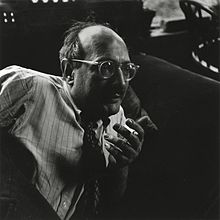Mark Rothko | |
|---|---|
 | |
| Born | Markus Yakovlevich Rothkowitz September 25, 1903 |
| Died | February 25, 1970 (aged 66) New York City, U.S. |
| Nationality | American |
| Alma mater | Yale University |
| Known for | Painting |
| Movement | Abstract expressionism, color field |
| Spouse(s) | Edith Sachar (1932–1943) Mary Alice "Mell" Beistle (1944–1970) |
| Children | Kate Rothko Prizel (b. Kathy Lynn Rothko, 1950)[1] and Christopher Rothko (b. 1963)[1] |
| Patron(s) | Peggy Guggenheim, John de Menil, Dominique de Menil |
Mark Rothko (/ˈrɒθkoʊ/ ROTH-koh; Markus Yakovlevich Rothkowitz until 1940; September 25, 1903 – February 25, 1970) was an American abstract painter. He is best known for his color field paintings that depicted irregular and painterly rectangular regions of color, which he produced from 1949 to 1970. Although Rothko did not personally subscribe to any one school, he is associated with the American abstract expressionism movement of modern art.
Born in Daugavpils, Latvia, then under occupation by the Russian Empire, Rothko and his family emigrated to the United States, arriving at Ellis Island in late 1913 and originally settling in Portland, Oregon. He moved to New York City in 1923 where his youthful period of artistic production dealt primarily with urban scenery. In response to World War II, Rothko's art entered a transitional phase during the 1940s, where he experimented with mythological themes and Surrealism to express tragedy. Toward the end of the decade, Rothko painted canvases with regions of pure color which he further abstracted into rectangular color forms, the idiom he would use for the rest of his life.
In his later career, Rothko executed several canvases for three different mural projects. The Seagram murals were to have decorated the Four Seasons Restaurant in the Seagram Building, but Rothko eventually grew disgusted with the idea that his paintings would be decorative objects for wealthy diners and refunded the lucrative commission, donating the paintings to museums including the Tate Gallery. The Harvard Mural series was donated to a dining room in Harvard's Holyoke Center (now Smith Campus Center); their colors faded badly over time due to Rothko's use of the pigment lithol red together with regular sunlight exposure. The Harvard series has since been restored using a special lighting technique.[2] Rothko contributed 14 canvases to a permanent installation at the Rothko Chapel, a non-denominational chapel in Houston, Texas.
Although Rothko lived modestly for much of his life, the resale value of his paintings grew tremendously in the decades following his suicide in 1970. His painting No. 6 (Violet, Green and Red) sold in 2014 for $186 million.[3]
- ^ a b Cite error: The named reference
Guardian 2008was invoked but never defined (see the help page). - ^ "Reviving Mark Rothko's Harvard Murals Using Light". Architect Magazine. February 18, 2015. Retrieved September 11, 2024.
- ^ DiMarco, Sarah. "These Are the 10 Most Expensive Paintings in the World". Veranda. Hearst Digital Media. Retrieved January 13, 2024.